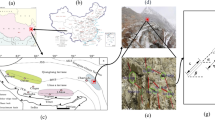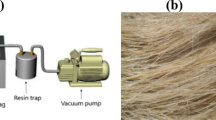Abstract
Interlaminar fracture is the most common type of failure in polymeric textile composites because these composites are prone to delaminate under the influence of external loading. Depending on the type of loading, the delamination in textile composites can be classified into Mode-I, Mode-II, Mode-III, and Mixed Mode-I/II interlaminar fracture. In this research work, Mode-I interlaminar fracture modeling of a double cantilever beam (DCB) composite laminate is performed on ABAQUS software as a cost-effective approach. The finite element-based fracture modeling techniques, virtual crack closure technique (VCCT), cohesive zone modeling (CZM), and extended finite element method (XFEM) were employed under the two-dimensional and three-dimensional interlayer crack propagation to evaluate several load–displacement responses. The top and bottom parts of the DCB specimen were bonded to each other by defining the bonded node set between their surfaces and the interaction properties given to these bonded nodes in the VCCT and CZM (Surface) techniques. A layer of cohesive element was provided between the top and bottom parts of the DCB specimen in the CZM (Element) approach to investigate the crack growth behavior. The XFEM technique is based on arbitrary crack propagation, so the initial crack path and top–bottom parts of the DCB specimen are not required to define in the XFEM technique. The XFEM technique was employed with VCCT and CZM techniques using the enrichment function. The stress-based criteria was used for crack initiation, whereas the energy-based approach was used for crack propagation in DCB laminate. The numerically simulated responses were compared with the published experimental load–displacement responses and agreed well. A parametric study of various fracture parameters (cohesive strength, fracture energy, interfacial stiffness, laminate thickness, and pre-crack length) was conducted to understand their effects on load–displacement responses of the Mode-I interlaminar fracture. The several fracture modeling techniques were compared by considering the element type, shape, total elements, accuracy, run-time, increments, and convergence speed. The surface-based fracture modeling approaches showed a high dependency on mesh size. All the fracture modeling approaches validate the experimental trend; however, the three-dimensional XFEM–CZM technique showed excellent accuracy with moderate mesh dependency and took the highest computer consumption time. Thus, it was found as the most significant interlaminar fracture modeling technique for the prediction of crack behavior to a large extent.









































Similar content being viewed by others

References
Kundu T (2012) Fundamentals of fracture mechanics. CRC Press, Taylor and Francis Group
Kumar P (2009) Elements of fracture mechanics. Mc Graw Hill Education (India) Private Limited, New York
Tay TE (2003) Characterization and analysis of delamination fracture in composites: an overview of developments from 1990 to 2001. Appl Mech Rev 56:1–32
Anderson TL (2005) Fracture mechanics: fundamentals and applications, 4th edn. CRC Press, Boca Raton
Wisnom MR (2012) The role of delamination in failure of fibre-reinforced composites. Trans R Soc A 370:1850–1870
Sharma P, Priyanka P, Mali HS, Dixit A (2020) Geometric modeling and finite element analysis of kevlar monolithic and carbon-kevlar hybrid woven fabric unit cell. Mater Today Proc 26:766–774
Sharma P, Mali HS, Dixit A (2021) Mechanical behavior and fracture toughness characterization of high strength fiber reinforced polymer textile composites. Iran Polym J 30:193–233
Krueger R (2015) The virtual crack closure technique for modeling interlaminar failure and delamination in advanced composite materials. Elsevier Ltd, Amsterdam
Kim SC, Kim JS, Yoon HJ (2011) Experimental and numerical investigations of mode I delamination behaviors of woven fabric composites with carbon, kevlar and their hybrid fibers. Int J Precis Eng Manuf 12:321–329
Irwin GR (1957) Analysis of stresses and strains near the end of a crack traversing a plate. J Appl Mech 24:361–364
Rybicki EF, Kanninen MF (1977) A finite element calculation of stress intensity factors by a modified crack closure integral. Eng Fract Mech 9:931–938
Jokinen J, Wallin M, Saarela O (2015) Applicability of VCCT in mode I loading of yielding adhesively bonded joints—a case study. Int J Adhes Adhes 62:85–91
Jokinen J, Kanerva M, Wallin M, Saarela O (2019) The simulation of a double cantilever beam test using the virtual crack closure technique with the cohesive zone modelling. Int J Adhes Adhes 88:50–58
Senthil K, Arockiarajan A, Palaninathan R (2018) Numerical study on the onset of initiation of debond growth in adhesively bonded composite joints. Int J Adhes Adhes 84:202–219
Karmakov S, Cepero-Mejías F, Curiel-Sosa JL (2020) Numerical analysis of the delamination in CFRP laminates: VCCT and XFEM assessment. Compos Part C Open Access 2:100014
Teimouri F, Heidari-Rarani M, Haji Aboutalebi F (2021) An XFEM–VCCT coupled approach for modeling mode I fatigue delamination in composite laminates under high cycle loading. Eng Fract Mech 249:107760
Gliszczynski A, Samborski S, Wiacek N, Rzeczkowski J (2019) Mode I interlaminar fracture of glass/epoxy unidirectional laminates. Part II: numerical analysis. Materials (Basel) 12:1604
Yamanaka T (2011) Delamination modelling and toughening mechanism of a woven fabric composite. McGill University, Canada
Pereira AB, de Morais AB (2004) Mode I interlaminar fracture of carbon/epoxy multidirectional laminates. Compos Sci Technol 64:2261–2270
Yu Z, Zhang J, Shen J, Chen H (2021) Simulation of crack propagation behavior of nuclear graphite by using XFEM, VCCT and CZM methods. Nucl Mater Energy 29:101063
Ghadirdokht A, Heidari-Rarani M (2019) Delamination R-curve behavior of curved composite laminates. Compos Part B Eng 175:107139
Zhang J, Wang J, Yuan Z, Jia H (2018) Effect of the cohesive law shape on the modelling of adhesive joints bonded with brittle and ductile adhesives. Int J Adhes Adhes 85:37–43
Abbaszadeh Bidokhti A, Shahani AR, Amini Fasakhodi MR (2017) Displacement-controlled crack growth in double cantilever beam specimen: a comparative study of different models. Proc Inst Mech Eng Part C J Mech Eng Sci 231:2835–2847
Sahoo SS, Panda SK, Mahapatra TR, Hirwani CK (2019) Numerical analysis of transient responses of delaminated layered structure using different mid-plane theories and experimental validation. Iran J Sci Technol Trans Mech Eng 43:41–56
ABAQUS (2006) Online Documentation Version 6.6-1, User’s Manual
Low KO, Teng SM, Johar M, Israr HA, Wong KJ (2019) Mode I delamination behaviour of carbon/epoxy composite at different displacement rates. Compos Part B Eng 176:107293
Hosseini MR, Taheri-Behrooz F, Salamat-talab M (2019) Mode I interlaminar fracture toughness of woven glass/epoxy composites with mat layers at delamination interface. Polym Test 78:105943
Kaushik V, Ghosh A (2019) Experimental and numerical characterization of Mode I fracture in unidirectional CFRP laminated composite using XIGA-CZM approach. Eng Fract Mech 211:221–243
Teimouri F, Heidari-Rarani M, Haji Aboutalebi F (2021) Finite element modeling of mode I fatigue delamination growth in composites under large-scale fiber bridging. Compos Struct 263:113716
Saeedi M, Azadi M, Mokhtarishirazabad M, Lopez-Crespo P (2021) Numerical simulations of carbon/epoxy laminated composites under various loading rates, comparing extended finite element method and cohesive zone modeling. Mater Des Process Commun 3:198
Barile C, Casavola C, Gambino B, Mellone A, Spagnolo M (2019) Mode-I fracture behavior of CFRPs: numerical model of the experimental results. Materials (Basel) 12:513
Gong Y et al (2022) Experimental and numerical investigations on the mode I delamination growth behavior of laminated composites with different z-pin fiber reinforcements. Compos Struct 287:115370
Bergan A, Dávila C, Leone F, Awerbuch J, Tan TM (2016) A Mode I cohesive law characterization procedure for through-the-thickness crack propagation in composite laminates. Compos Part B Eng 94:338–349
Zhao L, Gong Y, Zhang J, Chen Y, Fei B (2014) Simulation of delamination growth in multidirectional laminates under mode I and mixed mode I/II loadings using cohesive elements. Compos Struct 116:509–522
Ramalho LDC, Campilho RDSG, Belinha J, da Silva LFM (2020) Static strength prediction of adhesive joints: a review. Int J Adhes Adhes 96:102451
Belytschko T, Blace T (1999) Elastic crack growth in finite elements with minimal remeshing. Int J Numer Methods Eng 45:601–620
Djebbar SC et al (2022) Substrate geometry effect on the strength of repaired plates: combined XFEM and CZM approach. Int J Adhes Adhes 119:103252
Sonkar V, Bhattacharya S, Sharma K (2022) Numerical simulation of three dimensional fracture mechanics problems of functionally graded pipe and pipe bend using XFEM. Iran J Sci Technol Trans Mech Eng 46:1031–1045
Swati RF, Wen LH, Elahi H, Khan AA, Shad S (2019) Extended finite element method (XFEM) analysis of fiber reinforced composites for prediction of micro-crack propagation and delaminations in progressive damage: a review. Microsyst Technol 25:747–763
Swati RF, Hua WL, Elahi H, Khan AA (2018) XFEM damage analysis of carbon fiber reinforced composites and crack propagation in mixed-mode and implementation of the method using ABAQUS. Int J Mater Mech Manuf 6:286–290
Benzaama A, Mokhtari M, Benzaama H, Gouasmi S, Tamine T (2018) Using XFEM technique to predict the damage of unidirectional CFRP composite notched under tensile load. Adv Aircr Spacecr Sci 5:129–139
Swati RF et al (2022) Micro-mechanical investigation of interfacial debonding in carbon fiber-reinforced composites using extended finite element method (XFEM) approach. Micromachines 13:1226
Al-Dakheel H, Temitope I, Albinmousa J, Al-Athel K (2021) Modeling fatigue crack growth in CFRP adhesively bonded substrate using XFEM. In: ASME International Mechanical Engineering Congress and Exposition, vol 12
Zhao C et al (2022) Intralaminar crack propagation of glass fiber reinforced composite laminate. Structures 41:787–803
Ahmad H, Sugiman S, Zainun NY (2020) XFEM modelling of single-lap woven fabric kenaf composites bolted joints with temperature action. Lat Am J Solids Struct 17:273
Swati RF, Wen LH, Elahi H, Khan AA, Shad S (2019) Experimental and numerical investigation of transversal damage in carbon fiber reinforced composites using X-FEM analysis. J Mech Sci Technol 33:205–211
Wu EM, Reuter Jr RC (1965) Crack extension in fiberglass reinforced plastics. Dept Theor Appl Mech Illinois Univ Urbana
Benzeggagh ML, Kenane MJCS (1996) Measurement of mixed-mode delamination fracture toughness of unidirectional glass/epoxy composites with mixed-mode bending apparatus. Compos Sci Technol 56:439–449
Reeder J, Song K, Chunchu P, Ambur D (2002) Postbuckling and growth of delaminations in composite plates subjected to axial compression in 43rd AIAA/ASME/ASCE/AHS/ASC structures, structural dynamics, and materials conference, (American Institute of Aeronautics and Astronautics (AIAA)), pp 1–10
Najimi M, Haji Aboutalebi F (2023) Mixed mode crack initiation and propagation in functionally graded materials: experimental and numerical investigations. Iran J Sci Technol Trans Mech Eng. https://doi.org/10.1007/s40997-023-00591-8
Viana G, Carbas R, Costa M, Banea M, da Silva L (2021) A new cohesive element to model environmental degradation of adhesive joints in the rail industry. Proc Inst Mech Eng Part C J Mech Eng Sci 235:560–570
Negi A, Bhardwaj G, Saini JS, Grover N (2019) Crack growth analysis of carbon nanotube reinforced polymer nanocomposite using extended finite element method. Proc Inst Mech Eng Part C J Mech Eng Sci 233:1750–1770
Acknowledgements
This study is financially supported by Defence Research and Development Organization (DRDO)—Armament Research Board (ARMREB), Govt. of India under Grant No: ARMREB/MAA/2019/213.
Author information
Authors and Affiliations
Contributions
Conceptualization, methodology, formal analysis, investigation, writing—original draft preparation, and validation [PS]; Resources, supervision, review and editing [HSM]; Supervision, review and editing [AD].
Corresponding author
Ethics declarations
Conflict of interest
The authors have no conflict of interest to declare that are relevant to the content of this article.
Additional information
Technical Editor: João Marciano Laredo dos Reis.
Publisher's Note
Springer Nature remains neutral with regard to jurisdictional claims in published maps and institutional affiliations.
Rights and permissions
Springer Nature or its licensor (e.g. a society or other partner) holds exclusive rights to this article under a publishing agreement with the author(s) or other rightsholder(s); author self-archiving of the accepted manuscript version of this article is solely governed by the terms of such publishing agreement and applicable law.
About this article
Cite this article
Sharma, P., Mali, H.S. & Dixit, A. Mode-I interlaminar fracture modeling of DCB composite laminate using finite element techniques. J Braz. Soc. Mech. Sci. Eng. 45, 512 (2023). https://doi.org/10.1007/s40430-023-04427-z
Received:
Accepted:
Published:
DOI: https://doi.org/10.1007/s40430-023-04427-z



